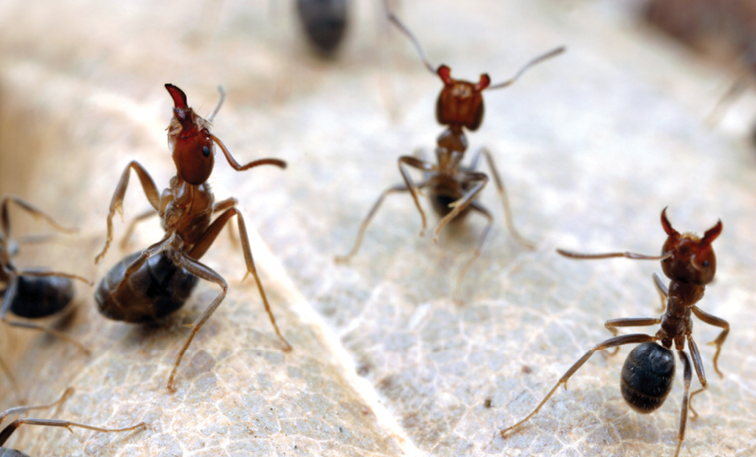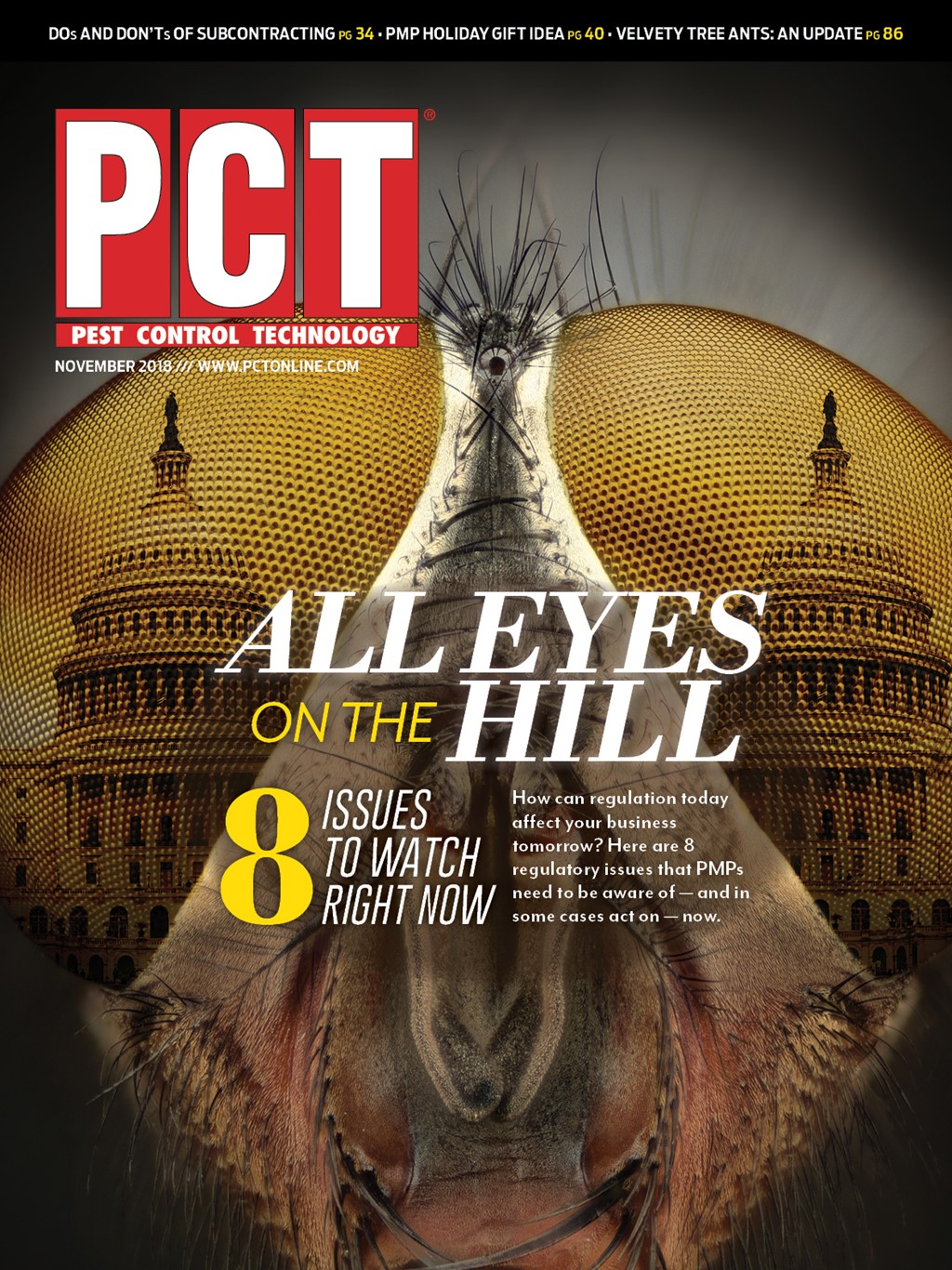
Ants rule our world! There are 20 to 25 structurally invasive pest ant species in the United States. Of these pest ant species, a few are categorized as wood-infesting organisms, such as “moisture” ants (Lasius spp.) and carpenter ants (Camponotus spp.). However, there is one wood-destroying ant group that isn’t as celebrated as a moisture or carpenter ant: Velvety tree ants (Liometopum spp.).
There are three North American velvety tree ant species: Liometopum apiculatum, L. luctuosum and L. occidentale (Del Toro et al. 2009). The omnivorous velvety tree ants are members of the ant subfamily Dolichoderinae. The ants possess a single node, are polymorphic and their colonies contain multiple queens. The ants received their “velvety” name designation because their abdomens are covered with numerous hairs (Klotz et al. 2008) but I still like to imagine that they are cloaked in velvet smoking jackets. Further, do not confuse velvety tree ants with colloquially termed “velvet” ants, which are wingless wasps found in the family Mutillidae.
Liometopum apiculatum are primarily found in the Southwest U.S. and Mexico (Hoey-Chamberlain and Rust 2014) and aren’t characterized as pests. In fact, the larvae of these ants are a Mexican delicacy (Ruiz-Cabrera et al. 2015). (If you find yourself traveling south of the border, stop by a restaurant and order a round of escamoles cooked in butter!)
However, Liometopum luctuosum (also known as the pine tree ant) and L. occidentale are considered to be structural pests (Hoey-Chamberlain et al. 2013). The ants are commonly encountered in the Pacific Northwest, Southwest U.S. and California. Liometopum luctuosum is uniformly brownish-black in color, ranging in size from 2.5 to 4.5 mm, while L. occidentale are 2.5 to 5.5 mm and bi-colored with a black head/abdomen and red thoracic region (Del Toro et al. 2009). Colony sizes for both species range from 40,000 to 60,000 workers (Hoey-Chamberlain et al. 2013).
Velvety tree ants tend to construct shallow nests in the soil, under fallen timber or within trees (Klotz et al. 2008). Due to their appearance and close association with timber, velvety tree ants are commonly misidentified as carpenter ants. Like carpenter ants, their nests are composed of “carton” but frass produced by the ants can be used as a diagnostic tool to separate the ants from one another. Carpenter ants produce coarse frass while velvety tree ants produce frass with a finer consistency (Klotz et al. 2008).
In addition to carpenter ants, velvety tree ants (specifically L. luctuosum) also may be confused with odorous house ants (OHA). The two ants possess similar morphological characteristics and produce similar smelling odors, but velvety tree ants are more aggressive, biting and releasing defensive secretions when provoked. PMPs often crush ants and smell the odors as a species identification method. The method is beneficial at times, but some ants produce similar smells, so technicians should learn additional distinguishing characteristics to prevent misidentification.
CONTROL TIPS. At this point, you should be prepared to swim through the “velvety tree ant biology” category on Jeopardy! Well, until that day comes, let’s focus on a few velvety tree ant management tips.
First, speak with the customer to gain some intel regarding the issue. Customers can provide information pertinent to ant management such as pest sighting location, duration of pest activity and if there were any recent moisture problems. Any moisture-related issue needs to be identified and corrected because the ants will always seek out moist areas. Any leaks or puddles of standing water could lead to further structural issues in the future. Information provided by the customer also can be used to support identification efforts. Accurate information and a proper identification leads to the selection of appropriate control strategies. After the proper identification has been made, a thorough inspection should be completed. Start the inspection on the interior of the structure beginning with the locations where velvety tree ant activity has been documented.
Velvety tree ants are wood-chewing machines so take note of any piles of wood shavings or frass. The ants also are fond of insulation, which may appear in frass/wood piles as well. Velvety tree ants will construct nests within wall voids, but these nests aren’t permanent and may not contain reproductive ants. As a result, every attempt should be made to follow the ants’ foraging trails to locate their primary nest(s) outside the structure.
Nests may be found in trees, within fallen timber or tree stumps. These items can be treated with an appropriately labeled liquid or dust pesticide. To provide greater residual control, a liquid bait station can be placed near the nest(s). To prevent recurrent issues, a perimeter liquid treatment may be applied and any trees and shrubs in contact with the structure should be pruned. Ants take the path of least resistance into a structure and untrimmed limbs could serve as a highway into a building. Inside structures, dust formulations can be applied to satellite nests and baits can be used near foraging trails.
The author is director of training and technical services, Senske Services, Kennewick, Wash.
References
Del Toro, I., Pacheco, J.A., and Mackay, W.P. 2009. Revision of the ant genus Liometopum (Hymenoptera: Formicidae). Sociobiol. 53: 299-369.
Hoey-Chamberlain, R. and Rust, M.K. 2014. The survivorship and water loss of Liometopum luctuosum (Hymenoptera: Formicidae) and Liometopum occidentale (Hymenoptera: Formicidae) exposed to different temperatures and relative humidity. J. Insect Sci. 14(249). http://doi.org/10.1093/jisesa/ieu111
Hoey-Chamberlain, R., Rust, M.K., and Klotz, J.H. 2013. A review of the biology, ecology and behavior of velvety tree ants of North America. Sociobiol. 60: 1-10.
Klotz, J., Hansen, L., Pospischil, R., and Rust, M.K. 2008. Urban ants of North America and Europe. Ithaca, N.Y., Cornell University Press.
Ruiz-Cabrera, M.A., Anda-Salazar, A.D., González-García, R., Abud-Archila, M., and Grajales-Lagunes, A. 2015. CYTA-J Food. 13: 188-195.

Explore the November 2018 Issue
Check out more from this issue and find your next story to read.
Latest from Pest Control Technology
- A Cautionary Tale of Honey Bees and Heat
- Mingle a Mile High in Denver
- PMP Helping Those in Need by Ensuring Secondhand Furniture is Free of Bed Bugs
- PPMA Unveils New Design of Mainframe Site
- UCR Entomologist Makes a Case for Eating Bugs
- Brown Recluse Spider Management: Correcting Contributing Conditions
- FMC Announces Donation to PestVets Give Back Program
- Liphatech Announces Refreshed Brand, Website and New Strategic Direction





